Global Business Strategy Report
VerifiedAdded on 2020/01/16
|12
|3087
|229
Report
AI Summary
This report provides a comprehensive analysis of global business strategy, using HSBC Bank PLC as a case study. It begins by outlining techniques for analyzing the business environment, including SWOT and PESTLE analyses, and Porter's Five Forces model. The report then delves into the micro and macro environments of HSBC, examining the impact of the international business environment on its operations. A detailed assessment of the benefits, opportunities, and challenges of globalization for HSBC is presented, followed by a discussion of the extent of globalization's influence on organizations and different organizational structures (decentralized, centralized, and hybrid). Finally, a critical evaluation of HSBC's international operations is conducted, considering factors such as political risk, religious diversity, and varying laws and regulations. The report concludes by summarizing the significant impact of globalization on HSBC's success in the international banking industry.
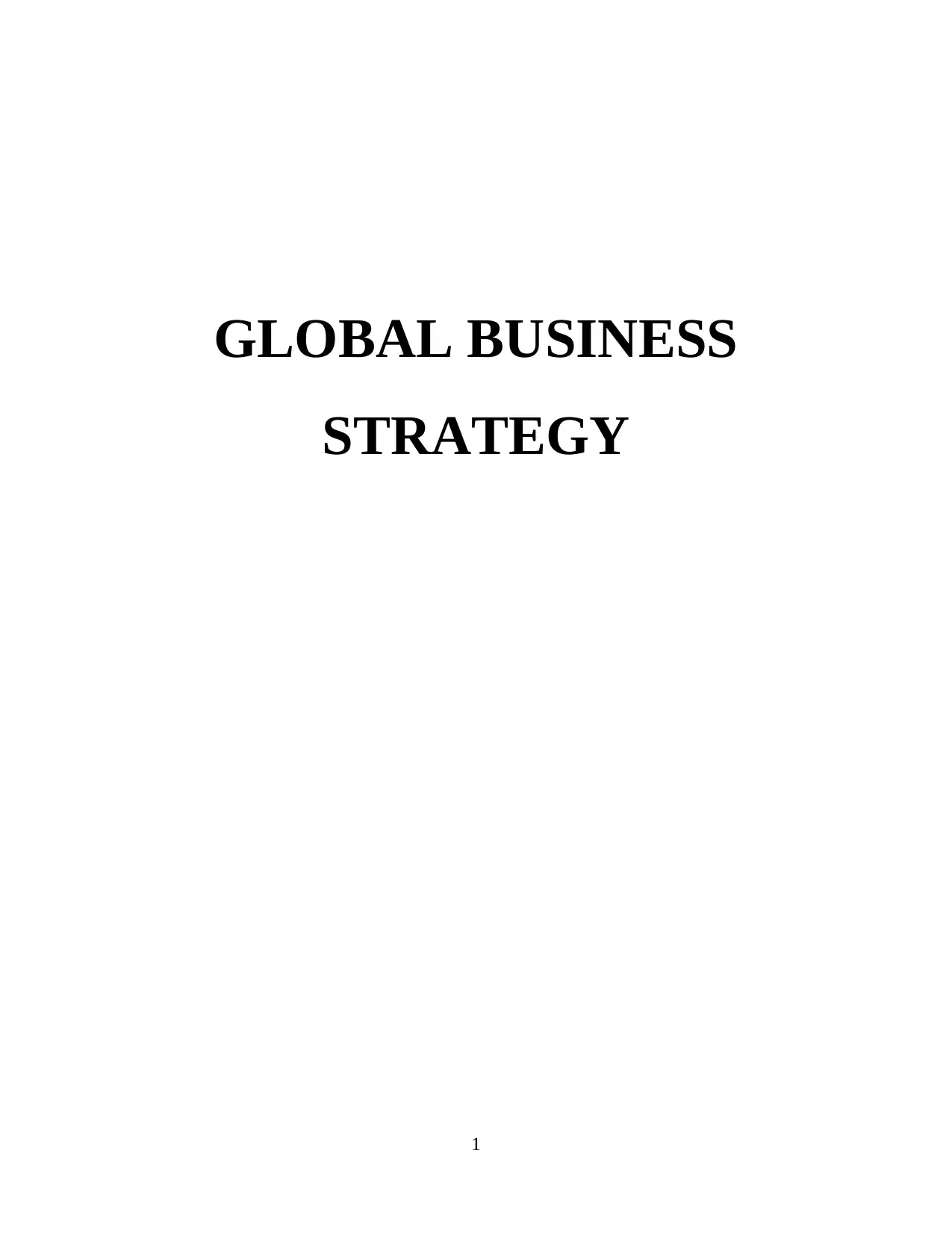
GLOBAL BUSINESS
STRATEGY
1
STRATEGY
1
Paraphrase This Document
Need a fresh take? Get an instant paraphrase of this document with our AI Paraphraser
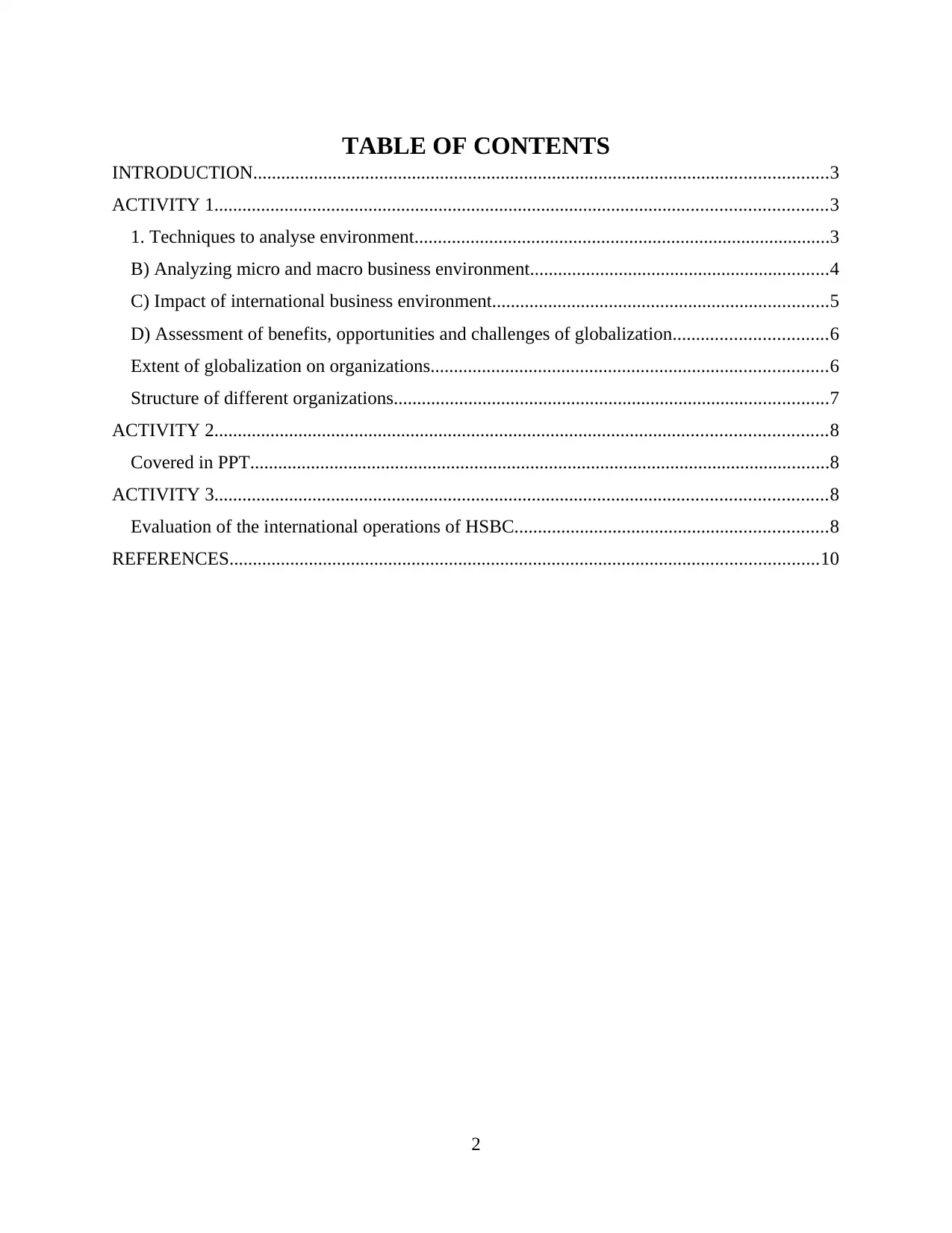
TABLE OF CONTENTS
INTRODUCTION...........................................................................................................................3
ACTIVITY 1...................................................................................................................................3
1. Techniques to analyse environment.........................................................................................3
B) Analyzing micro and macro business environment................................................................4
C) Impact of international business environment........................................................................5
D) Assessment of benefits, opportunities and challenges of globalization.................................6
Extent of globalization on organizations.....................................................................................6
Structure of different organizations.............................................................................................7
ACTIVITY 2...................................................................................................................................8
Covered in PPT............................................................................................................................8
ACTIVITY 3...................................................................................................................................8
Evaluation of the international operations of HSBC...................................................................8
REFERENCES..............................................................................................................................10
2
INTRODUCTION...........................................................................................................................3
ACTIVITY 1...................................................................................................................................3
1. Techniques to analyse environment.........................................................................................3
B) Analyzing micro and macro business environment................................................................4
C) Impact of international business environment........................................................................5
D) Assessment of benefits, opportunities and challenges of globalization.................................6
Extent of globalization on organizations.....................................................................................6
Structure of different organizations.............................................................................................7
ACTIVITY 2...................................................................................................................................8
Covered in PPT............................................................................................................................8
ACTIVITY 3...................................................................................................................................8
Evaluation of the international operations of HSBC...................................................................8
REFERENCES..............................................................................................................................10
2
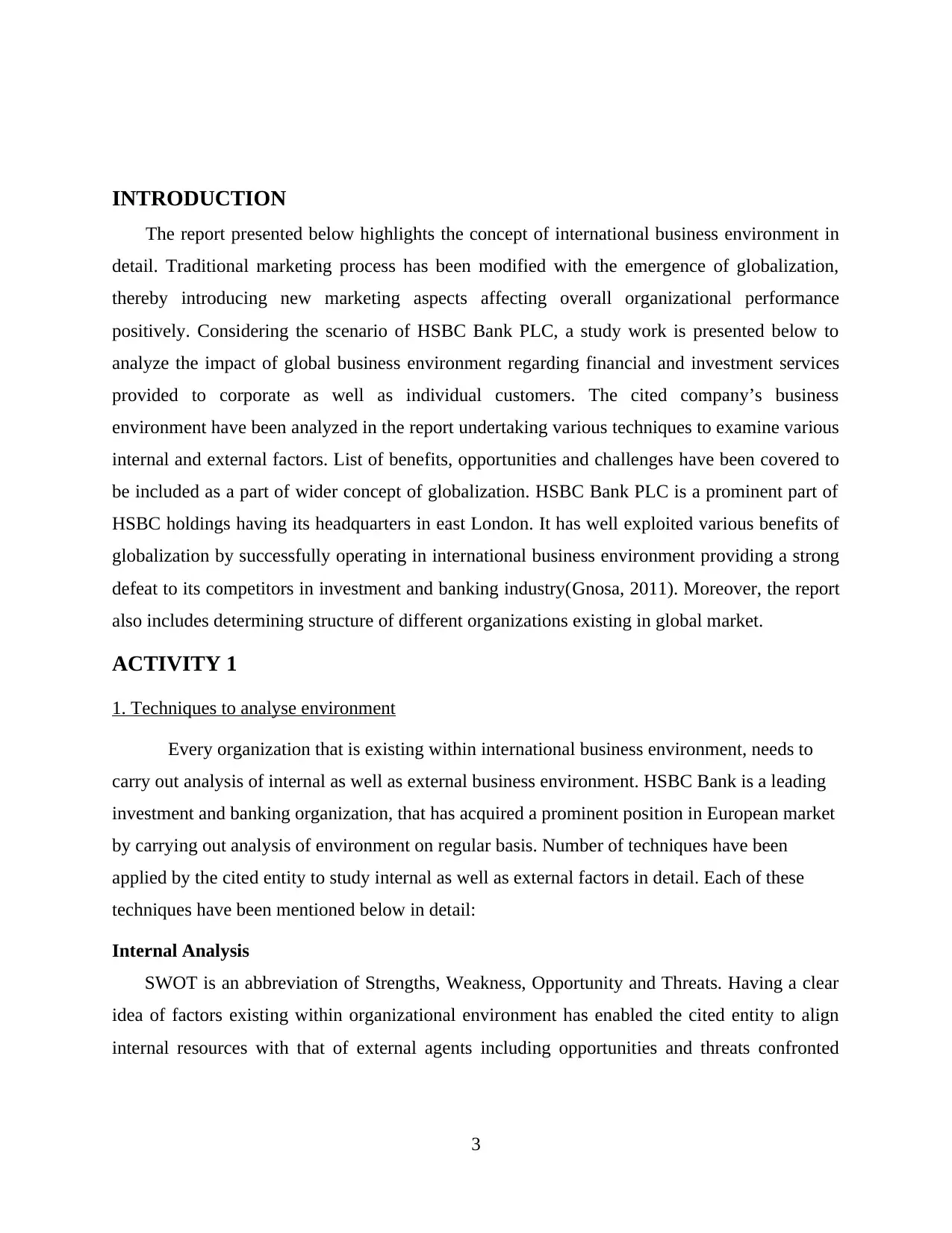
INTRODUCTION
The report presented below highlights the concept of international business environment in
detail. Traditional marketing process has been modified with the emergence of globalization,
thereby introducing new marketing aspects affecting overall organizational performance
positively. Considering the scenario of HSBC Bank PLC, a study work is presented below to
analyze the impact of global business environment regarding financial and investment services
provided to corporate as well as individual customers. The cited company’s business
environment have been analyzed in the report undertaking various techniques to examine various
internal and external factors. List of benefits, opportunities and challenges have been covered to
be included as a part of wider concept of globalization. HSBC Bank PLC is a prominent part of
HSBC holdings having its headquarters in east London. It has well exploited various benefits of
globalization by successfully operating in international business environment providing a strong
defeat to its competitors in investment and banking industry(Gnosa, 2011). Moreover, the report
also includes determining structure of different organizations existing in global market.
ACTIVITY 1
1. Techniques to analyse environment
Every organization that is existing within international business environment, needs to
carry out analysis of internal as well as external business environment. HSBC Bank is a leading
investment and banking organization, that has acquired a prominent position in European market
by carrying out analysis of environment on regular basis. Number of techniques have been
applied by the cited entity to study internal as well as external factors in detail. Each of these
techniques have been mentioned below in detail:
Internal Analysis
SWOT is an abbreviation of Strengths, Weakness, Opportunity and Threats. Having a clear
idea of factors existing within organizational environment has enabled the cited entity to align
internal resources with that of external agents including opportunities and threats confronted
3
The report presented below highlights the concept of international business environment in
detail. Traditional marketing process has been modified with the emergence of globalization,
thereby introducing new marketing aspects affecting overall organizational performance
positively. Considering the scenario of HSBC Bank PLC, a study work is presented below to
analyze the impact of global business environment regarding financial and investment services
provided to corporate as well as individual customers. The cited company’s business
environment have been analyzed in the report undertaking various techniques to examine various
internal and external factors. List of benefits, opportunities and challenges have been covered to
be included as a part of wider concept of globalization. HSBC Bank PLC is a prominent part of
HSBC holdings having its headquarters in east London. It has well exploited various benefits of
globalization by successfully operating in international business environment providing a strong
defeat to its competitors in investment and banking industry(Gnosa, 2011). Moreover, the report
also includes determining structure of different organizations existing in global market.
ACTIVITY 1
1. Techniques to analyse environment
Every organization that is existing within international business environment, needs to
carry out analysis of internal as well as external business environment. HSBC Bank is a leading
investment and banking organization, that has acquired a prominent position in European market
by carrying out analysis of environment on regular basis. Number of techniques have been
applied by the cited entity to study internal as well as external factors in detail. Each of these
techniques have been mentioned below in detail:
Internal Analysis
SWOT is an abbreviation of Strengths, Weakness, Opportunity and Threats. Having a clear
idea of factors existing within organizational environment has enabled the cited entity to align
internal resources with that of external agents including opportunities and threats confronted
3
⊘ This is a preview!⊘
Do you want full access?
Subscribe today to unlock all pages.

Trusted by 1+ million students worldwide
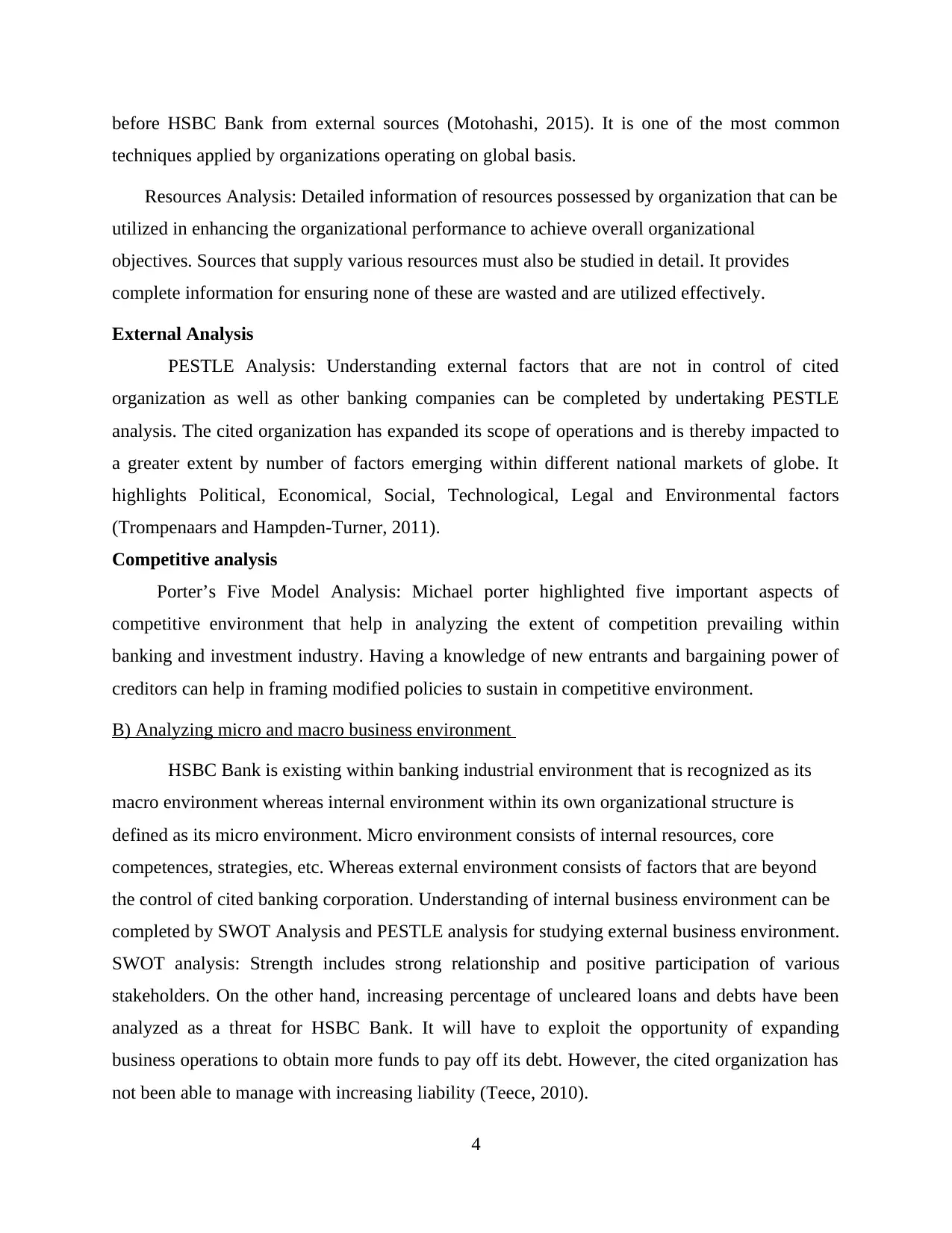
before HSBC Bank from external sources (Motohashi, 2015). It is one of the most common
techniques applied by organizations operating on global basis.
Resources Analysis: Detailed information of resources possessed by organization that can be
utilized in enhancing the organizational performance to achieve overall organizational
objectives. Sources that supply various resources must also be studied in detail. It provides
complete information for ensuring none of these are wasted and are utilized effectively.
External Analysis
PESTLE Analysis: Understanding external factors that are not in control of cited
organization as well as other banking companies can be completed by undertaking PESTLE
analysis. The cited organization has expanded its scope of operations and is thereby impacted to
a greater extent by number of factors emerging within different national markets of globe. It
highlights Political, Economical, Social, Technological, Legal and Environmental factors
(Trompenaars and Hampden-Turner, 2011).
Competitive analysis
Porter’s Five Model Analysis: Michael porter highlighted five important aspects of
competitive environment that help in analyzing the extent of competition prevailing within
banking and investment industry. Having a knowledge of new entrants and bargaining power of
creditors can help in framing modified policies to sustain in competitive environment.
B) Analyzing micro and macro business environment
HSBC Bank is existing within banking industrial environment that is recognized as its
macro environment whereas internal environment within its own organizational structure is
defined as its micro environment. Micro environment consists of internal resources, core
competences, strategies, etc. Whereas external environment consists of factors that are beyond
the control of cited banking corporation. Understanding of internal business environment can be
completed by SWOT Analysis and PESTLE analysis for studying external business environment.
SWOT analysis: Strength includes strong relationship and positive participation of various
stakeholders. On the other hand, increasing percentage of uncleared loans and debts have been
analyzed as a threat for HSBC Bank. It will have to exploit the opportunity of expanding
business operations to obtain more funds to pay off its debt. However, the cited organization has
not been able to manage with increasing liability (Teece, 2010).
4
techniques applied by organizations operating on global basis.
Resources Analysis: Detailed information of resources possessed by organization that can be
utilized in enhancing the organizational performance to achieve overall organizational
objectives. Sources that supply various resources must also be studied in detail. It provides
complete information for ensuring none of these are wasted and are utilized effectively.
External Analysis
PESTLE Analysis: Understanding external factors that are not in control of cited
organization as well as other banking companies can be completed by undertaking PESTLE
analysis. The cited organization has expanded its scope of operations and is thereby impacted to
a greater extent by number of factors emerging within different national markets of globe. It
highlights Political, Economical, Social, Technological, Legal and Environmental factors
(Trompenaars and Hampden-Turner, 2011).
Competitive analysis
Porter’s Five Model Analysis: Michael porter highlighted five important aspects of
competitive environment that help in analyzing the extent of competition prevailing within
banking and investment industry. Having a knowledge of new entrants and bargaining power of
creditors can help in framing modified policies to sustain in competitive environment.
B) Analyzing micro and macro business environment
HSBC Bank is existing within banking industrial environment that is recognized as its
macro environment whereas internal environment within its own organizational structure is
defined as its micro environment. Micro environment consists of internal resources, core
competences, strategies, etc. Whereas external environment consists of factors that are beyond
the control of cited banking corporation. Understanding of internal business environment can be
completed by SWOT Analysis and PESTLE analysis for studying external business environment.
SWOT analysis: Strength includes strong relationship and positive participation of various
stakeholders. On the other hand, increasing percentage of uncleared loans and debts have been
analyzed as a threat for HSBC Bank. It will have to exploit the opportunity of expanding
business operations to obtain more funds to pay off its debt. However, the cited organization has
not been able to manage with increasing liability (Teece, 2010).
4
Paraphrase This Document
Need a fresh take? Get an instant paraphrase of this document with our AI Paraphraser
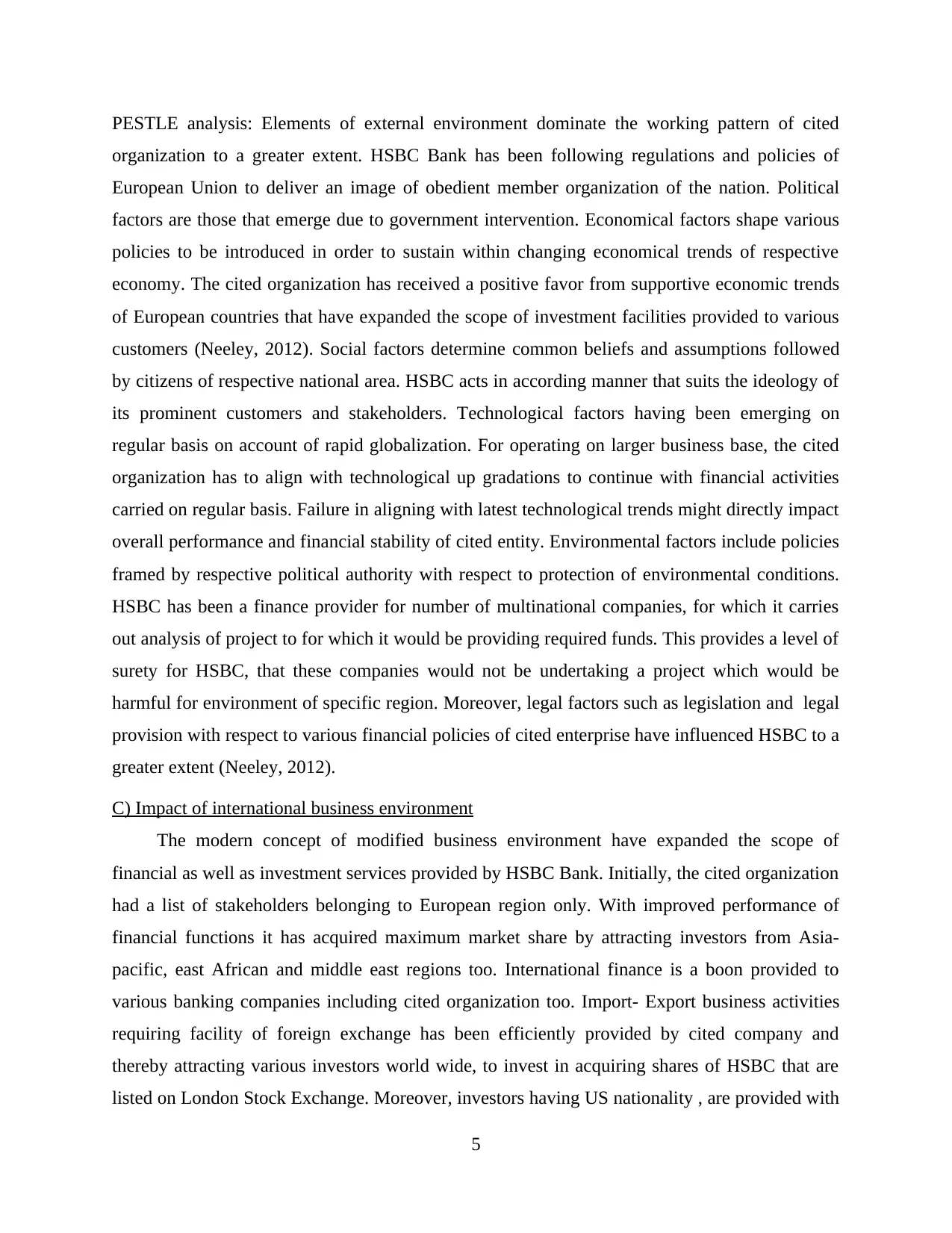
PESTLE analysis: Elements of external environment dominate the working pattern of cited
organization to a greater extent. HSBC Bank has been following regulations and policies of
European Union to deliver an image of obedient member organization of the nation. Political
factors are those that emerge due to government intervention. Economical factors shape various
policies to be introduced in order to sustain within changing economical trends of respective
economy. The cited organization has received a positive favor from supportive economic trends
of European countries that have expanded the scope of investment facilities provided to various
customers (Neeley, 2012). Social factors determine common beliefs and assumptions followed
by citizens of respective national area. HSBC acts in according manner that suits the ideology of
its prominent customers and stakeholders. Technological factors having been emerging on
regular basis on account of rapid globalization. For operating on larger business base, the cited
organization has to align with technological up gradations to continue with financial activities
carried on regular basis. Failure in aligning with latest technological trends might directly impact
overall performance and financial stability of cited entity. Environmental factors include policies
framed by respective political authority with respect to protection of environmental conditions.
HSBC has been a finance provider for number of multinational companies, for which it carries
out analysis of project to for which it would be providing required funds. This provides a level of
surety for HSBC, that these companies would not be undertaking a project which would be
harmful for environment of specific region. Moreover, legal factors such as legislation and legal
provision with respect to various financial policies of cited enterprise have influenced HSBC to a
greater extent (Neeley, 2012).
C) Impact of international business environment
The modern concept of modified business environment have expanded the scope of
financial as well as investment services provided by HSBC Bank. Initially, the cited organization
had a list of stakeholders belonging to European region only. With improved performance of
financial functions it has acquired maximum market share by attracting investors from Asia-
pacific, east African and middle east regions too. International finance is a boon provided to
various banking companies including cited organization too. Import- Export business activities
requiring facility of foreign exchange has been efficiently provided by cited company and
thereby attracting various investors world wide, to invest in acquiring shares of HSBC that are
listed on London Stock Exchange. Moreover, investors having US nationality , are provided with
5
organization to a greater extent. HSBC Bank has been following regulations and policies of
European Union to deliver an image of obedient member organization of the nation. Political
factors are those that emerge due to government intervention. Economical factors shape various
policies to be introduced in order to sustain within changing economical trends of respective
economy. The cited organization has received a positive favor from supportive economic trends
of European countries that have expanded the scope of investment facilities provided to various
customers (Neeley, 2012). Social factors determine common beliefs and assumptions followed
by citizens of respective national area. HSBC acts in according manner that suits the ideology of
its prominent customers and stakeholders. Technological factors having been emerging on
regular basis on account of rapid globalization. For operating on larger business base, the cited
organization has to align with technological up gradations to continue with financial activities
carried on regular basis. Failure in aligning with latest technological trends might directly impact
overall performance and financial stability of cited entity. Environmental factors include policies
framed by respective political authority with respect to protection of environmental conditions.
HSBC has been a finance provider for number of multinational companies, for which it carries
out analysis of project to for which it would be providing required funds. This provides a level of
surety for HSBC, that these companies would not be undertaking a project which would be
harmful for environment of specific region. Moreover, legal factors such as legislation and legal
provision with respect to various financial policies of cited enterprise have influenced HSBC to a
greater extent (Neeley, 2012).
C) Impact of international business environment
The modern concept of modified business environment have expanded the scope of
financial as well as investment services provided by HSBC Bank. Initially, the cited organization
had a list of stakeholders belonging to European region only. With improved performance of
financial functions it has acquired maximum market share by attracting investors from Asia-
pacific, east African and middle east regions too. International finance is a boon provided to
various banking companies including cited organization too. Import- Export business activities
requiring facility of foreign exchange has been efficiently provided by cited company and
thereby attracting various investors world wide, to invest in acquiring shares of HSBC that are
listed on London Stock Exchange. Moreover, investors having US nationality , are provided with
5
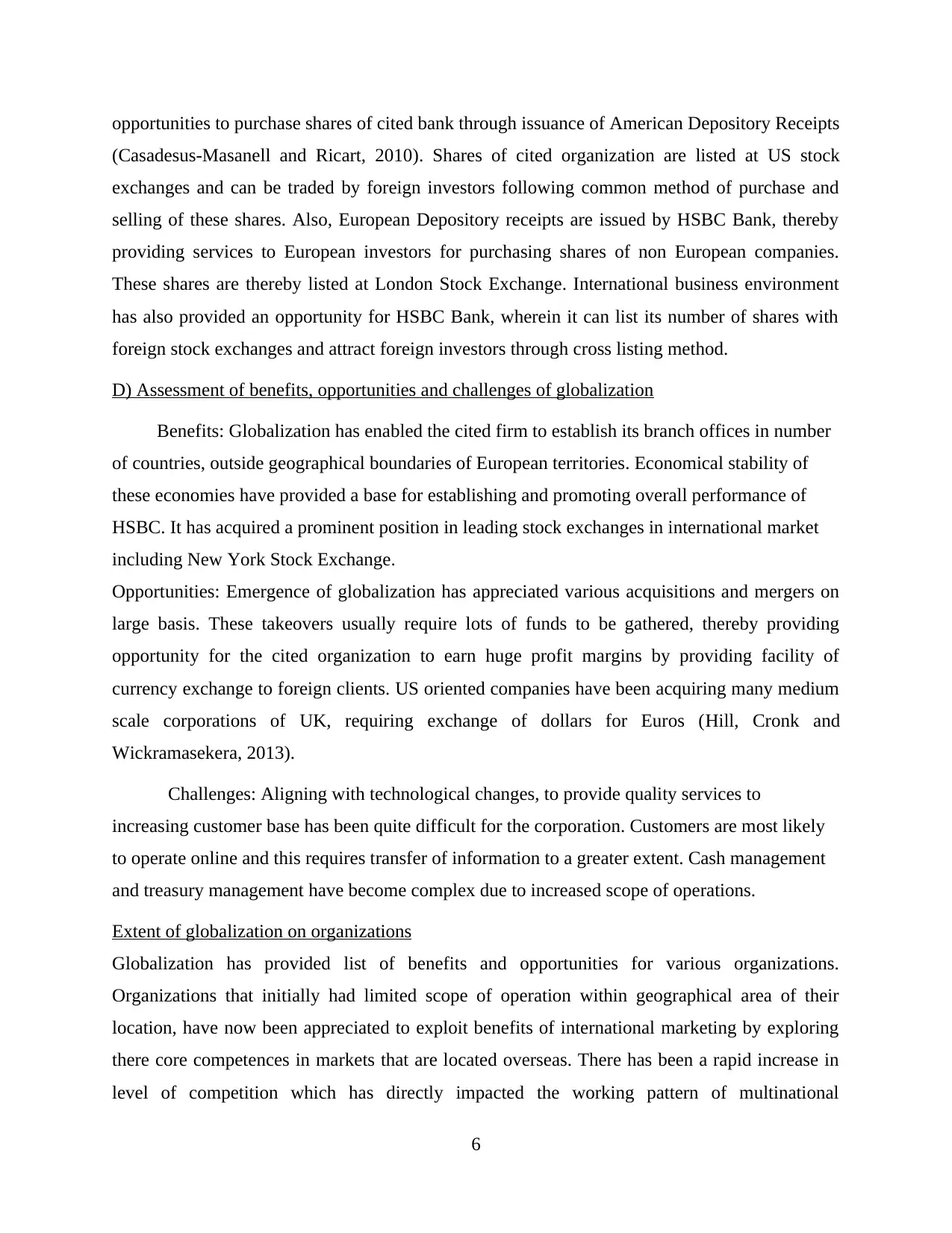
opportunities to purchase shares of cited bank through issuance of American Depository Receipts
(Casadesus-Masanell and Ricart, 2010). Shares of cited organization are listed at US stock
exchanges and can be traded by foreign investors following common method of purchase and
selling of these shares. Also, European Depository receipts are issued by HSBC Bank, thereby
providing services to European investors for purchasing shares of non European companies.
These shares are thereby listed at London Stock Exchange. International business environment
has also provided an opportunity for HSBC Bank, wherein it can list its number of shares with
foreign stock exchanges and attract foreign investors through cross listing method.
D) Assessment of benefits, opportunities and challenges of globalization
Benefits: Globalization has enabled the cited firm to establish its branch offices in number
of countries, outside geographical boundaries of European territories. Economical stability of
these economies have provided a base for establishing and promoting overall performance of
HSBC. It has acquired a prominent position in leading stock exchanges in international market
including New York Stock Exchange.
Opportunities: Emergence of globalization has appreciated various acquisitions and mergers on
large basis. These takeovers usually require lots of funds to be gathered, thereby providing
opportunity for the cited organization to earn huge profit margins by providing facility of
currency exchange to foreign clients. US oriented companies have been acquiring many medium
scale corporations of UK, requiring exchange of dollars for Euros (Hill, Cronk and
Wickramasekera, 2013).
Challenges: Aligning with technological changes, to provide quality services to
increasing customer base has been quite difficult for the corporation. Customers are most likely
to operate online and this requires transfer of information to a greater extent. Cash management
and treasury management have become complex due to increased scope of operations.
Extent of globalization on organizations
Globalization has provided list of benefits and opportunities for various organizations.
Organizations that initially had limited scope of operation within geographical area of their
location, have now been appreciated to exploit benefits of international marketing by exploring
there core competences in markets that are located overseas. There has been a rapid increase in
level of competition which has directly impacted the working pattern of multinational
6
(Casadesus-Masanell and Ricart, 2010). Shares of cited organization are listed at US stock
exchanges and can be traded by foreign investors following common method of purchase and
selling of these shares. Also, European Depository receipts are issued by HSBC Bank, thereby
providing services to European investors for purchasing shares of non European companies.
These shares are thereby listed at London Stock Exchange. International business environment
has also provided an opportunity for HSBC Bank, wherein it can list its number of shares with
foreign stock exchanges and attract foreign investors through cross listing method.
D) Assessment of benefits, opportunities and challenges of globalization
Benefits: Globalization has enabled the cited firm to establish its branch offices in number
of countries, outside geographical boundaries of European territories. Economical stability of
these economies have provided a base for establishing and promoting overall performance of
HSBC. It has acquired a prominent position in leading stock exchanges in international market
including New York Stock Exchange.
Opportunities: Emergence of globalization has appreciated various acquisitions and mergers on
large basis. These takeovers usually require lots of funds to be gathered, thereby providing
opportunity for the cited organization to earn huge profit margins by providing facility of
currency exchange to foreign clients. US oriented companies have been acquiring many medium
scale corporations of UK, requiring exchange of dollars for Euros (Hill, Cronk and
Wickramasekera, 2013).
Challenges: Aligning with technological changes, to provide quality services to
increasing customer base has been quite difficult for the corporation. Customers are most likely
to operate online and this requires transfer of information to a greater extent. Cash management
and treasury management have become complex due to increased scope of operations.
Extent of globalization on organizations
Globalization has provided list of benefits and opportunities for various organizations.
Organizations that initially had limited scope of operation within geographical area of their
location, have now been appreciated to exploit benefits of international marketing by exploring
there core competences in markets that are located overseas. There has been a rapid increase in
level of competition which has directly impacted the working pattern of multinational
6
⊘ This is a preview!⊘
Do you want full access?
Subscribe today to unlock all pages.

Trusted by 1+ million students worldwide
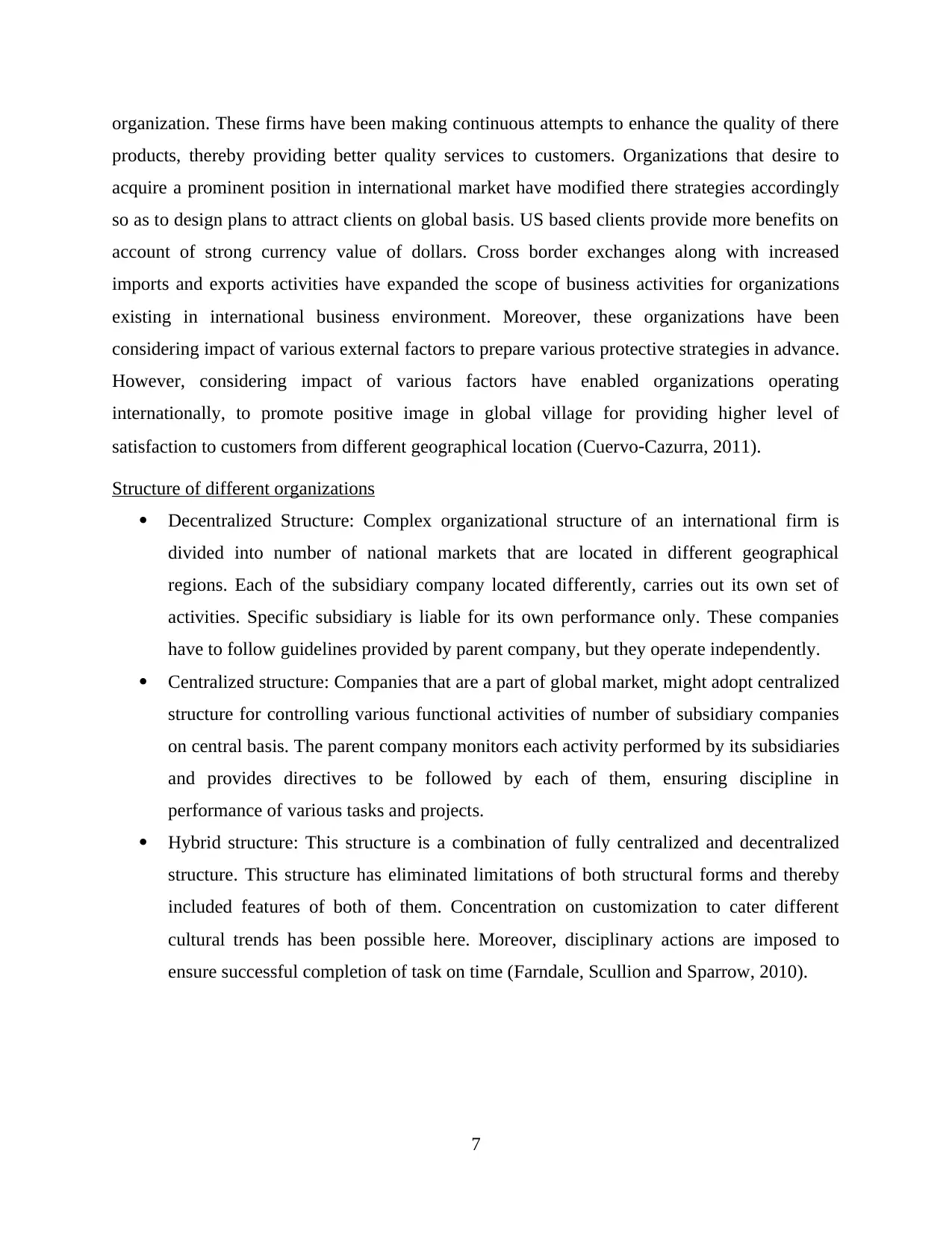
organization. These firms have been making continuous attempts to enhance the quality of there
products, thereby providing better quality services to customers. Organizations that desire to
acquire a prominent position in international market have modified there strategies accordingly
so as to design plans to attract clients on global basis. US based clients provide more benefits on
account of strong currency value of dollars. Cross border exchanges along with increased
imports and exports activities have expanded the scope of business activities for organizations
existing in international business environment. Moreover, these organizations have been
considering impact of various external factors to prepare various protective strategies in advance.
However, considering impact of various factors have enabled organizations operating
internationally, to promote positive image in global village for providing higher level of
satisfaction to customers from different geographical location (Cuervo‐Cazurra, 2011).
Structure of different organizations
Decentralized Structure: Complex organizational structure of an international firm is
divided into number of national markets that are located in different geographical
regions. Each of the subsidiary company located differently, carries out its own set of
activities. Specific subsidiary is liable for its own performance only. These companies
have to follow guidelines provided by parent company, but they operate independently.
Centralized structure: Companies that are a part of global market, might adopt centralized
structure for controlling various functional activities of number of subsidiary companies
on central basis. The parent company monitors each activity performed by its subsidiaries
and provides directives to be followed by each of them, ensuring discipline in
performance of various tasks and projects.
Hybrid structure: This structure is a combination of fully centralized and decentralized
structure. This structure has eliminated limitations of both structural forms and thereby
included features of both of them. Concentration on customization to cater different
cultural trends has been possible here. Moreover, disciplinary actions are imposed to
ensure successful completion of task on time (Farndale, Scullion and Sparrow, 2010).
7
products, thereby providing better quality services to customers. Organizations that desire to
acquire a prominent position in international market have modified there strategies accordingly
so as to design plans to attract clients on global basis. US based clients provide more benefits on
account of strong currency value of dollars. Cross border exchanges along with increased
imports and exports activities have expanded the scope of business activities for organizations
existing in international business environment. Moreover, these organizations have been
considering impact of various external factors to prepare various protective strategies in advance.
However, considering impact of various factors have enabled organizations operating
internationally, to promote positive image in global village for providing higher level of
satisfaction to customers from different geographical location (Cuervo‐Cazurra, 2011).
Structure of different organizations
Decentralized Structure: Complex organizational structure of an international firm is
divided into number of national markets that are located in different geographical
regions. Each of the subsidiary company located differently, carries out its own set of
activities. Specific subsidiary is liable for its own performance only. These companies
have to follow guidelines provided by parent company, but they operate independently.
Centralized structure: Companies that are a part of global market, might adopt centralized
structure for controlling various functional activities of number of subsidiary companies
on central basis. The parent company monitors each activity performed by its subsidiaries
and provides directives to be followed by each of them, ensuring discipline in
performance of various tasks and projects.
Hybrid structure: This structure is a combination of fully centralized and decentralized
structure. This structure has eliminated limitations of both structural forms and thereby
included features of both of them. Concentration on customization to cater different
cultural trends has been possible here. Moreover, disciplinary actions are imposed to
ensure successful completion of task on time (Farndale, Scullion and Sparrow, 2010).
7
Paraphrase This Document
Need a fresh take? Get an instant paraphrase of this document with our AI Paraphraser
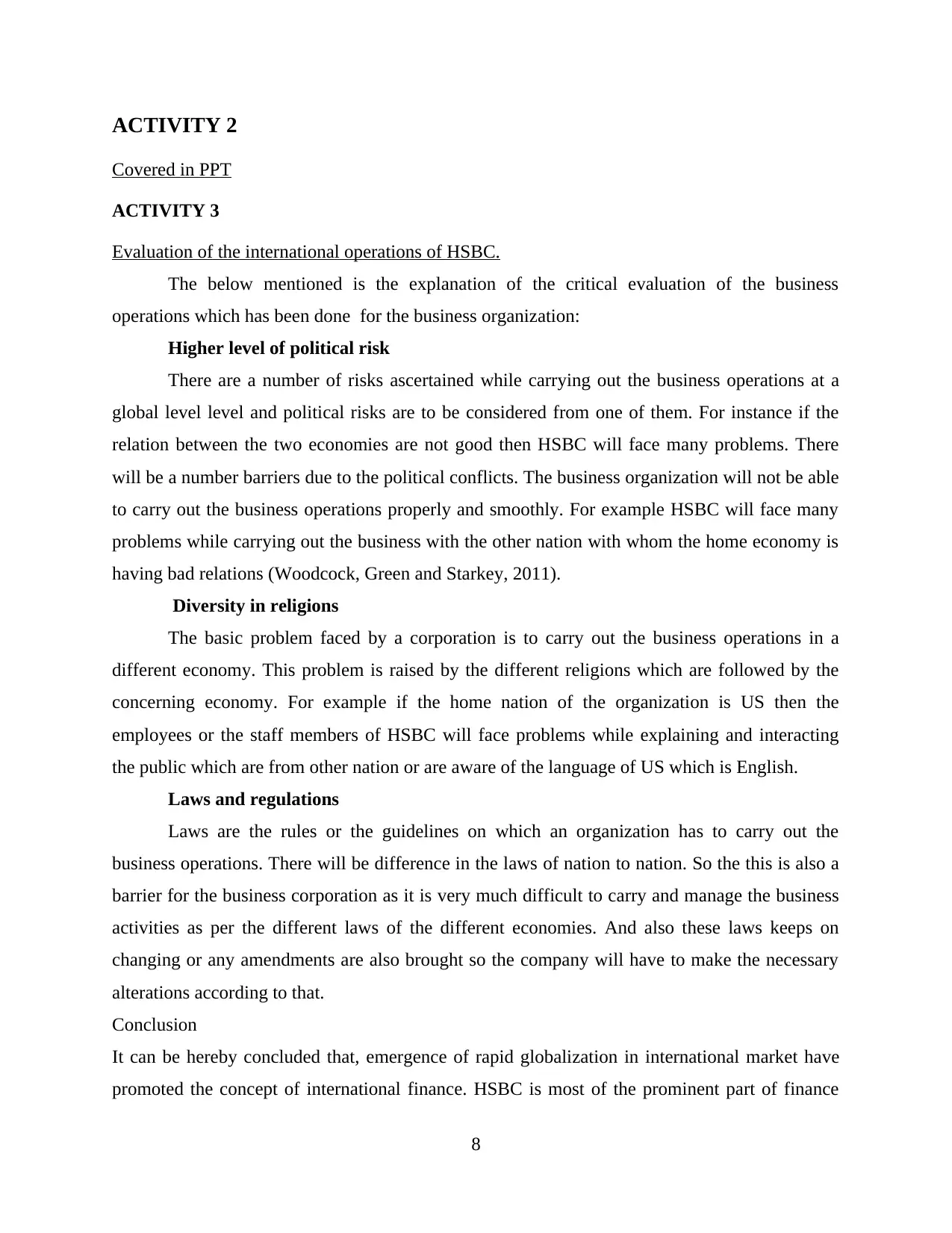
ACTIVITY 2
Covered in PPT
ACTIVITY 3
Evaluation of the international operations of HSBC.
The below mentioned is the explanation of the critical evaluation of the business
operations which has been done for the business organization:
Higher level of political risk
There are a number of risks ascertained while carrying out the business operations at a
global level level and political risks are to be considered from one of them. For instance if the
relation between the two economies are not good then HSBC will face many problems. There
will be a number barriers due to the political conflicts. The business organization will not be able
to carry out the business operations properly and smoothly. For example HSBC will face many
problems while carrying out the business with the other nation with whom the home economy is
having bad relations (Woodcock, Green and Starkey, 2011).
Diversity in religions
The basic problem faced by a corporation is to carry out the business operations in a
different economy. This problem is raised by the different religions which are followed by the
concerning economy. For example if the home nation of the organization is US then the
employees or the staff members of HSBC will face problems while explaining and interacting
the public which are from other nation or are aware of the language of US which is English.
Laws and regulations
Laws are the rules or the guidelines on which an organization has to carry out the
business operations. There will be difference in the laws of nation to nation. So the this is also a
barrier for the business corporation as it is very much difficult to carry and manage the business
activities as per the different laws of the different economies. And also these laws keeps on
changing or any amendments are also brought so the company will have to make the necessary
alterations according to that.
Conclusion
It can be hereby concluded that, emergence of rapid globalization in international market have
promoted the concept of international finance. HSBC is most of the prominent part of finance
8
Covered in PPT
ACTIVITY 3
Evaluation of the international operations of HSBC.
The below mentioned is the explanation of the critical evaluation of the business
operations which has been done for the business organization:
Higher level of political risk
There are a number of risks ascertained while carrying out the business operations at a
global level level and political risks are to be considered from one of them. For instance if the
relation between the two economies are not good then HSBC will face many problems. There
will be a number barriers due to the political conflicts. The business organization will not be able
to carry out the business operations properly and smoothly. For example HSBC will face many
problems while carrying out the business with the other nation with whom the home economy is
having bad relations (Woodcock, Green and Starkey, 2011).
Diversity in religions
The basic problem faced by a corporation is to carry out the business operations in a
different economy. This problem is raised by the different religions which are followed by the
concerning economy. For example if the home nation of the organization is US then the
employees or the staff members of HSBC will face problems while explaining and interacting
the public which are from other nation or are aware of the language of US which is English.
Laws and regulations
Laws are the rules or the guidelines on which an organization has to carry out the
business operations. There will be difference in the laws of nation to nation. So the this is also a
barrier for the business corporation as it is very much difficult to carry and manage the business
activities as per the different laws of the different economies. And also these laws keeps on
changing or any amendments are also brought so the company will have to make the necessary
alterations according to that.
Conclusion
It can be hereby concluded that, emergence of rapid globalization in international market have
promoted the concept of international finance. HSBC is most of the prominent part of finance
8
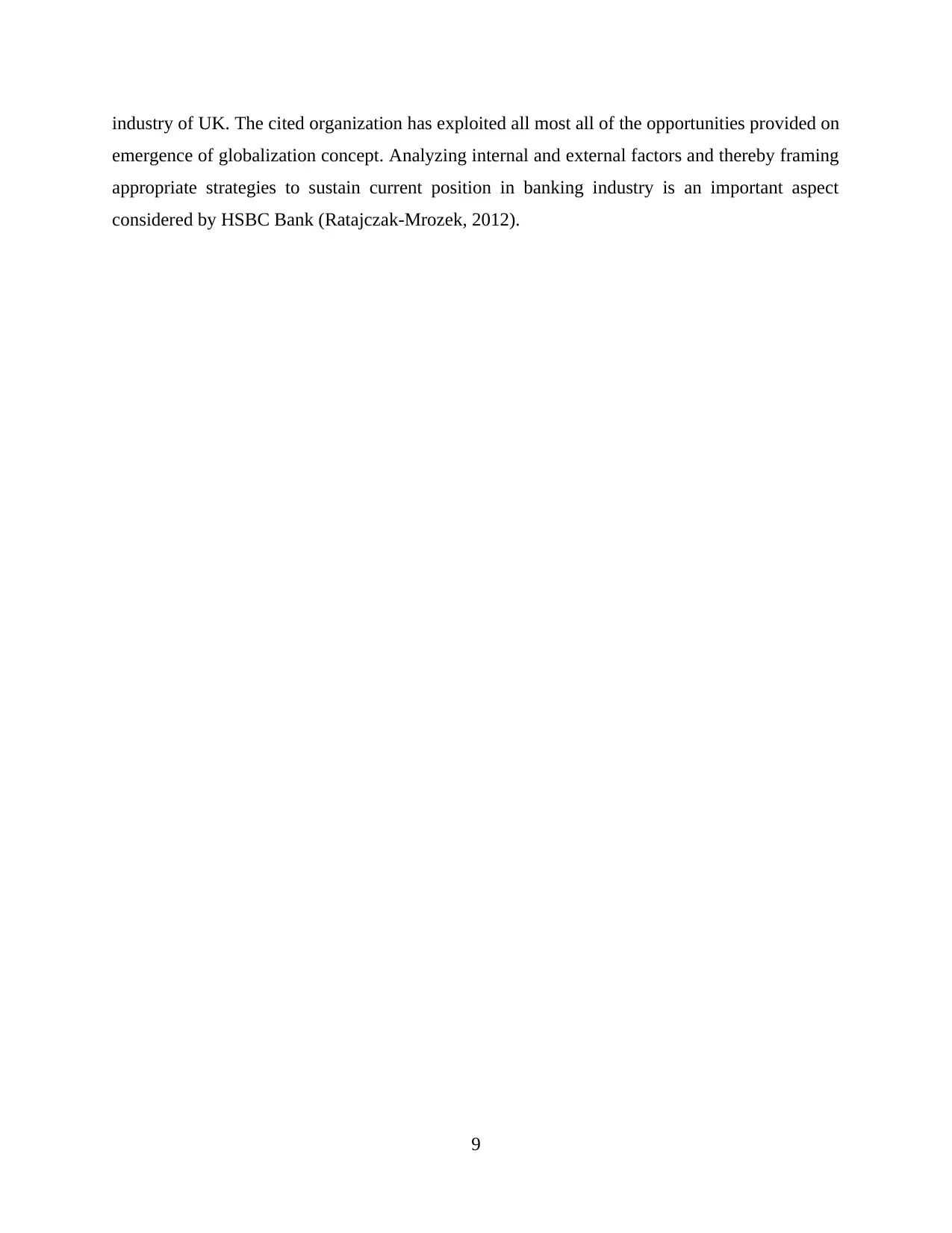
industry of UK. The cited organization has exploited all most all of the opportunities provided on
emergence of globalization concept. Analyzing internal and external factors and thereby framing
appropriate strategies to sustain current position in banking industry is an important aspect
considered by HSBC Bank (Ratajczak-Mrozek, 2012).
9
emergence of globalization concept. Analyzing internal and external factors and thereby framing
appropriate strategies to sustain current position in banking industry is an important aspect
considered by HSBC Bank (Ratajczak-Mrozek, 2012).
9
⊘ This is a preview!⊘
Do you want full access?
Subscribe today to unlock all pages.

Trusted by 1+ million students worldwide
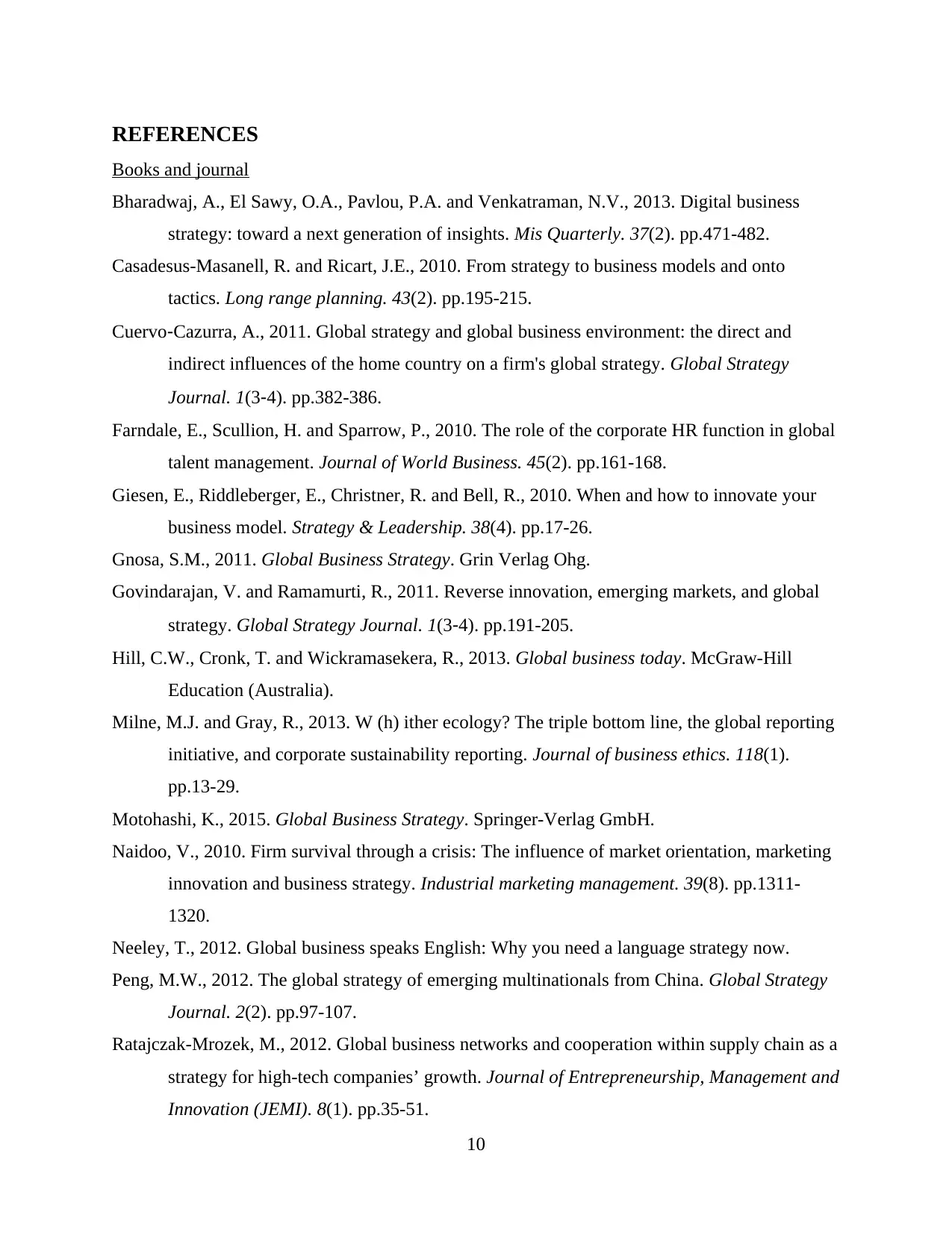
REFERENCES
Books and journal
Bharadwaj, A., El Sawy, O.A., Pavlou, P.A. and Venkatraman, N.V., 2013. Digital business
strategy: toward a next generation of insights. Mis Quarterly. 37(2). pp.471-482.
Casadesus-Masanell, R. and Ricart, J.E., 2010. From strategy to business models and onto
tactics. Long range planning. 43(2). pp.195-215.
Cuervo‐Cazurra, A., 2011. Global strategy and global business environment: the direct and
indirect influences of the home country on a firm's global strategy. Global Strategy
Journal. 1(3‐4). pp.382-386.
Farndale, E., Scullion, H. and Sparrow, P., 2010. The role of the corporate HR function in global
talent management. Journal of World Business. 45(2). pp.161-168.
Giesen, E., Riddleberger, E., Christner, R. and Bell, R., 2010. When and how to innovate your
business model. Strategy & Leadership. 38(4). pp.17-26.
Gnosa, S.M., 2011. Global Business Strategy. Grin Verlag Ohg.
Govindarajan, V. and Ramamurti, R., 2011. Reverse innovation, emerging markets, and global
strategy. Global Strategy Journal. 1(3‐4). pp.191-205.
Hill, C.W., Cronk, T. and Wickramasekera, R., 2013. Global business today. McGraw-Hill
Education (Australia).
Milne, M.J. and Gray, R., 2013. W (h) ither ecology? The triple bottom line, the global reporting
initiative, and corporate sustainability reporting. Journal of business ethics. 118(1).
pp.13-29.
Motohashi, K., 2015. Global Business Strategy. Springer-Verlag GmbH.
Naidoo, V., 2010. Firm survival through a crisis: The influence of market orientation, marketing
innovation and business strategy. Industrial marketing management. 39(8). pp.1311-
1320.
Neeley, T., 2012. Global business speaks English: Why you need a language strategy now.
Peng, M.W., 2012. The global strategy of emerging multinationals from China. Global Strategy
Journal. 2(2). pp.97-107.
Ratajczak-Mrozek, M., 2012. Global business networks and cooperation within supply chain as a
strategy for high-tech companies’ growth. Journal of Entrepreneurship, Management and
Innovation (JEMI). 8(1). pp.35-51.
10
Books and journal
Bharadwaj, A., El Sawy, O.A., Pavlou, P.A. and Venkatraman, N.V., 2013. Digital business
strategy: toward a next generation of insights. Mis Quarterly. 37(2). pp.471-482.
Casadesus-Masanell, R. and Ricart, J.E., 2010. From strategy to business models and onto
tactics. Long range planning. 43(2). pp.195-215.
Cuervo‐Cazurra, A., 2011. Global strategy and global business environment: the direct and
indirect influences of the home country on a firm's global strategy. Global Strategy
Journal. 1(3‐4). pp.382-386.
Farndale, E., Scullion, H. and Sparrow, P., 2010. The role of the corporate HR function in global
talent management. Journal of World Business. 45(2). pp.161-168.
Giesen, E., Riddleberger, E., Christner, R. and Bell, R., 2010. When and how to innovate your
business model. Strategy & Leadership. 38(4). pp.17-26.
Gnosa, S.M., 2011. Global Business Strategy. Grin Verlag Ohg.
Govindarajan, V. and Ramamurti, R., 2011. Reverse innovation, emerging markets, and global
strategy. Global Strategy Journal. 1(3‐4). pp.191-205.
Hill, C.W., Cronk, T. and Wickramasekera, R., 2013. Global business today. McGraw-Hill
Education (Australia).
Milne, M.J. and Gray, R., 2013. W (h) ither ecology? The triple bottom line, the global reporting
initiative, and corporate sustainability reporting. Journal of business ethics. 118(1).
pp.13-29.
Motohashi, K., 2015. Global Business Strategy. Springer-Verlag GmbH.
Naidoo, V., 2010. Firm survival through a crisis: The influence of market orientation, marketing
innovation and business strategy. Industrial marketing management. 39(8). pp.1311-
1320.
Neeley, T., 2012. Global business speaks English: Why you need a language strategy now.
Peng, M.W., 2012. The global strategy of emerging multinationals from China. Global Strategy
Journal. 2(2). pp.97-107.
Ratajczak-Mrozek, M., 2012. Global business networks and cooperation within supply chain as a
strategy for high-tech companies’ growth. Journal of Entrepreneurship, Management and
Innovation (JEMI). 8(1). pp.35-51.
10
Paraphrase This Document
Need a fresh take? Get an instant paraphrase of this document with our AI Paraphraser
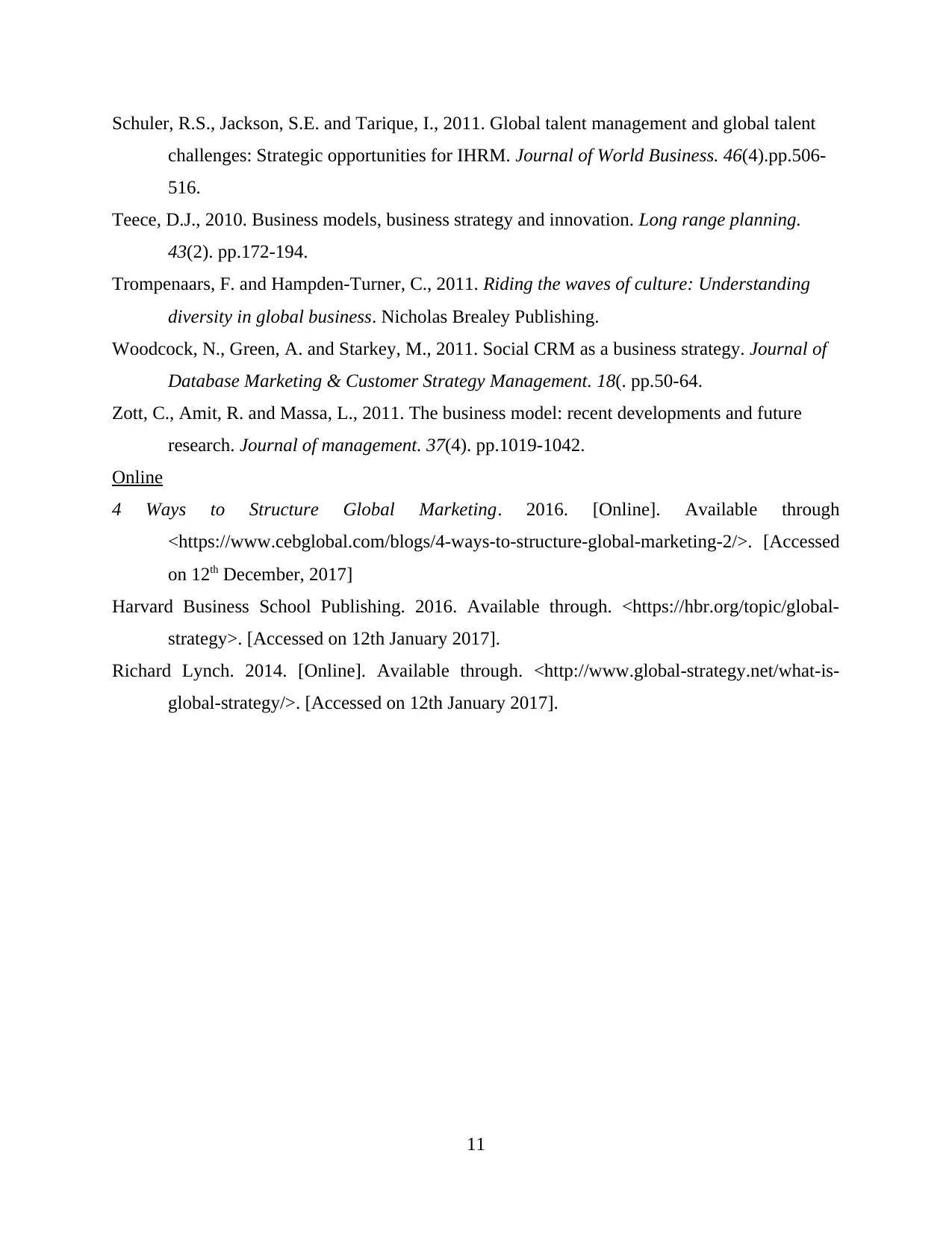
Schuler, R.S., Jackson, S.E. and Tarique, I., 2011. Global talent management and global talent
challenges: Strategic opportunities for IHRM. Journal of World Business. 46(4).pp.506-
516.
Teece, D.J., 2010. Business models, business strategy and innovation. Long range planning.
43(2). pp.172-194.
Trompenaars, F. and Hampden-Turner, C., 2011. Riding the waves of culture: Understanding
diversity in global business. Nicholas Brealey Publishing.
Woodcock, N., Green, A. and Starkey, M., 2011. Social CRM as a business strategy. Journal of
Database Marketing & Customer Strategy Management. 18(. pp.50-64.
Zott, C., Amit, R. and Massa, L., 2011. The business model: recent developments and future
research. Journal of management. 37(4). pp.1019-1042.
Online
4 Ways to Structure Global Marketing. 2016. [Online]. Available through
<https://www.cebglobal.com/blogs/4-ways-to-structure-global-marketing-2/>. [Accessed
on 12th December, 2017]
Harvard Business School Publishing. 2016. Available through. <https://hbr.org/topic/global-
strategy>. [Accessed on 12th January 2017].
Richard Lynch. 2014. [Online]. Available through. <http://www.global-strategy.net/what-is-
global-strategy/>. [Accessed on 12th January 2017].
11
challenges: Strategic opportunities for IHRM. Journal of World Business. 46(4).pp.506-
516.
Teece, D.J., 2010. Business models, business strategy and innovation. Long range planning.
43(2). pp.172-194.
Trompenaars, F. and Hampden-Turner, C., 2011. Riding the waves of culture: Understanding
diversity in global business. Nicholas Brealey Publishing.
Woodcock, N., Green, A. and Starkey, M., 2011. Social CRM as a business strategy. Journal of
Database Marketing & Customer Strategy Management. 18(. pp.50-64.
Zott, C., Amit, R. and Massa, L., 2011. The business model: recent developments and future
research. Journal of management. 37(4). pp.1019-1042.
Online
4 Ways to Structure Global Marketing. 2016. [Online]. Available through
<https://www.cebglobal.com/blogs/4-ways-to-structure-global-marketing-2/>. [Accessed
on 12th December, 2017]
Harvard Business School Publishing. 2016. Available through. <https://hbr.org/topic/global-
strategy>. [Accessed on 12th January 2017].
Richard Lynch. 2014. [Online]. Available through. <http://www.global-strategy.net/what-is-
global-strategy/>. [Accessed on 12th January 2017].
11

12
⊘ This is a preview!⊘
Do you want full access?
Subscribe today to unlock all pages.

Trusted by 1+ million students worldwide
1 out of 12
Related Documents
Your All-in-One AI-Powered Toolkit for Academic Success.
+13062052269
info@desklib.com
Available 24*7 on WhatsApp / Email
![[object Object]](/_next/static/media/star-bottom.7253800d.svg)
Unlock your academic potential
Copyright © 2020–2025 A2Z Services. All Rights Reserved. Developed and managed by ZUCOL.





